Japanese Karate Association
Kyu & Dan Rank Certification System
Japanese Karate Association
Kyu & Dan Rank Certification System
There are 10 Kyu (coloured belts) and 10 Dan (black belt levels) in JKA Karate. To obtain certification for each rank, you must fulfill the certification requirements and complete the testing procedure. Testing or grading is carried out by a panel of instructors authorised as JKA technical examiners. Click here for grading dates.
Please check with your authorised JKA/WF Australia representative regarding Kyu and Dan grading sessions. In order to be eligible for testing, you must first have gained the appropriate amount of continuous experience at your current rank. Then, depending on the level of Dan you are being graded for, you may have to take the test outside your own country or region (at the higher Dan ranks, only Tokyo JKA HQ is authorised to evaluate, grade and issue certification).
Kyu Kari (Gradings) is used in two ways:
- For kids below the age of 14 we use the kari as a grading level to promote encouragement.
- For students 15 years and above including adults, if for any reason that the student doesn’t pass their grading they can receive a kari level rather than failing them.
KYU & DAN
Duration Prerequisites
KYU & DAN
Duration Prerequisites
| Rank | Minimum Experience | Age | Location |
|---|---|---|---|
| No rank to 1st Kyu | 3 months | Dean Park Dojo | |
| 1st Dan | 6 months | Prefectural HQ or Branch dojo or group, with permission of Tokyo JKA HQ | |
| 2nd Dan | 1 yr at 1st Dan rank | National (Prefectural) HQ or Regional HQ, with permission of Tokyo JKA HQ | |
| 3rd Dan | 2 yrs at 2nd Dan rank | 18+ | National (Prefectural) HQ or Regional HQ, with permission of Tokyo JKA HQ |
| 4th Dan | 3 yrs at 3rd Dan rank | Tokyo JKA HQ or Regional HQ, with permission of Tokyo JKA HQ | |
| 5th Dan | 4 yrs at 4th Dan rank | 35+ | Tokyo JKA HQ or Regional HQ, with permission of Tokyo JKA HQ |
| 6th Dan | 6 yrs at 5th Dan rank | 42+ | Tokyo JKA HQ |
| 7th Dan | 7 yrs at 6th Dan rank | 50+ | Spring camp in JKA HQ or Autumn camp in JKA HQ or Funakoshi Gichin Cup world championships |
| 8th Dan | 7 yrs at 7th Dan rank | 60+ | Upon recommendation by Instructor Committee |
| 9th Dan | 8 yrs at 8th Dan rank | Upon recommendation by Instructor Committee | |
| 10th Dan | 9 yrs at 9th Dan rank | Upon recommendation by Instructor Committee |
BELT SYSTEM
JKA/WF AUSTRALIA Grading Prerequisites
BELT SYSTEM
JKA/WF AUSTRALIA Grading Prerequisites
| Kyu/Dan Rank | Colour | Criteria |
|---|---|---|
| No Rank | White | |
| 10th Kyu | White Belt black tip | Kihon |
| 9th Kyu | Yellow - White stripe | Kihon |
| 8th Kyu | Yellow | Kihon | Gohon Kumite | Taikyoku Shodan Kata |
| 7th Kyu | Orange | Kihon | Gohon Kumite | Heian Shodan Kata |
| 6th Kyu | Green | Kihon | Kihon Ippon Kumite | Heian Nidan Kata |
| 5th Kyu | Blue | Kihon | Kihon Ippon Kumite | Heian Sandan Kata |
| 4th Kyu | Purple | Kihon | Kihon Ippon Kumite | Heian Yondan Kata |
| 3rd Kyu | Brown | Kihon | Jiyu Ippon Kumite | Heian Gondan Kata |
| 2nd Kyu | Brown | Kihon | Jiyu Ippon Kumite | Tekki Shodan Kata |
| 1st Kyu | Brown | Kihon | Jiyu Ippon Kumite | Bassai Dai, Kanku Dai, Empi or Jion Kata |
| Shodan | Black | Kihon | Jiyu Ippon Kumite | Bassai Dai, Kanku Dai, Empi or Jion Kata |
| Nidan | Black | Kihon | Jiyu Kumite | Students favourite Kata |
| Sandan | Black | Kihon | Jiyu Kumite | Students favourite Kata |
| Yondan | Black | Kihon | Jiyu Kumite | Students favourite Kata |
| Godan | Black | Kihon | Jiyu Kumite | Students favourite Kata |
| Rokudan | Black | Specified by examiner |
| Shichidan | Black | Specified by examiner |
| Hachidan | Black | Recommendation by Shihankai |
| Kudan | Black | Recommendation by Shihankai |
| Judan | Black | Recommendation by Shihankai |
KYU
Grading Criteria
KYU
Grading Criteria
10th Kyu White Belt - Black tip

White signifies a birth, or beginning, of a seed. A white belt student is a beginner searching for knowledge of the Art. The white belt is the beginning of life's cycle, and represents the seed as it lies beneath the snow in the winter.
【KIHON】in place basics in shizen tai (hachiji dachi)
- CHUDAN CHOKU ZUKI
- JODAN AGE UKE
- CHUDAN SOTO UKE
- MAE GERI (HEISOKU DACHI, GEDAN KAKIWAKE)
* “GOREI” command (From right side in turn for each Waza)
9th Kyu Yellow - White Stripe
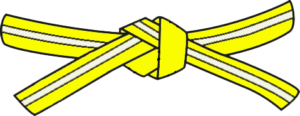 Yellow signifies the first beams of sunlight which shines upon the seed giving it new strength with the beginning of new life. A yellow belt student is given his first ray of knowledge, opening his/her mind, from his/her instructors.
Yellow signifies the first beams of sunlight which shines upon the seed giving it new strength with the beginning of new life. A yellow belt student is given his first ray of knowledge, opening his/her mind, from his/her instructors.
【KIHON】in place basics in shizen tai (hachiji dachi) to zenkutsu dachi and then back to shizen tai
- CHUDAN CHOKU ZUKI
- JODAN AGE UKE
- CHUDAN SOTO UKE
- KOKUTSU SHUTO UKE
- MAE GERI (HEISOKU DACHI, GEDAN KAKIWAKE)
* “GOREI” command (From right side two action in turn for each WAZA)
8th Kyu Yellow
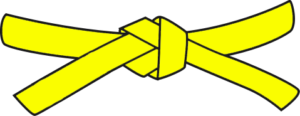
Yellow signifies the first beams of sunlight which shines upon the seed giving it new strength with the beginning of new life. A yellow belt student is given his first ray of knowledge, opening his/her mind, from his/her instructors.
【KIHON】idou kihon - moving basics from gedan barai in zenkutsu dachi
- CHUDAN JUNZUKI (step in)
- JODAN AGE UKE (step in)
- CHUDAN SOTO UKE (step in)
- GEDAN BARAI (step in)
- KOKUTSU SHUTO UKE (step in)
- MAE GERI (GEDAN KAKIWAKE) (step in)
【KATA】 TAIKYOKU SHODAN
【KUMITE】 GOHON KUMITE (JODAN JUNZUKI, CHUDAN JUNZUKI)
7th Kyu Orange

Orange represents the growing power of the sun as it warms the earth to prepare for new growth in the spring. The orange belt is starting to feel his body and mind open and develop.
【KIHON】idou kihon - moving basics from gedan barai in zenkutsu dachi
- CHUDAN JUNZUKI (step in)
- JODAN AGE UKE (step back)
- CHUDAN SOTO UKE (step in)
- CHUDAN UCHI UKE (step back)
- KOKUTSU SHUTO UKE (step in)
- MAE GERI (GEDAN KAKIWAKE) (step in)
- YOKO GERI KEAGE (in HEISOKU DACHI, right and left alternating)
- YOKO GERI KEKOMI (in HEISOKU DACHI, right and left alternating)
【KATA】 HEIAN SHODAN
【KUMITE】 GOHON KUMITE (JODAN JUNZUKI, CHUDAN JUNZUKI)
6th Kyu Green

Green signifies the growth of the seed as it sprouts from the earth reaching toward the sun and begins to grow into a plant. A green belt student learns to strengthen and refine his/her techniques.
【KIHON】 idou kihon - moving basics from gedan barai in zenkutsu dachi
- CHUDAN JUNZUKI (step in)
- JODAN AGE UKE (step back)
- CHUDAN SOTO UKE (step in)
- CHUDAN UCHI UKE (step back)
- KOKUTSU SHUTO UKE (step in)
- MAE GERI (GEDAN KAKIWAKE) (step in)
- YOKO GERI KEAGE (in KIBA DACHI, right and left) (step in)
- YOKO GERI KEKOMI (in KIBA DACHI, right and left) (step in)
【KATA】 HEIAN NIDAN
【KUMITE】KIHON IPPON KUMITE (JODAN JUNZUKI – right and left, CHUDAN JUNZUKI – right and left)
Attacking order to be right joudan, right chuudan, then left joudan, left chuudan
5th Kyu Blue
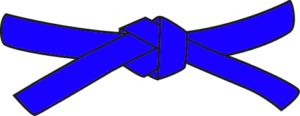
Blue signifies the blue sky as the plant continues to grow toward it. A blue belt student moves up higher in rank just as the plant grows taller. The light feeds the plant so it can continue to grow. The student is fed additional knowledge of the Art in order for his/her body and mind continue to grow and develop.
【KIHON】 idou kihon - moving basics from gedan barai in zenkutsu dachi
- CHUDAN JUNZUKI (step in)
- JODAN AGE UKE, GYAKU ZUKI (step back)
- CHUDAN SOTO UKE, GYAKU ZUKI (step in)
- CHUDAN UCHI UKE, GYAKU ZUKI (step back)
- KOKUTSU SHUTO UKE (step in)
- MAE GERI (GEDAN KAKIWAKE) (step in)
- YOKO GERI KEAGE (in KIBA DACHI, right and left) (step in)
- YOKO GERI KEKOMI (in KIBA DACHI, right and left) (step in)
【KATA】 HEIAN SANDAN
【KUMITE】KIHON IPPON KUMITE (JODAN JUNZUKI – right and left, CHUDAN JUNZUKI – right and left, CHUDAN MAEGERI GEDAN KAKIWAKE – right and left)
Attacking order to be right joudan, right chuudan, right maegeri, then left joudan, left chuudan and left maegeri
4th Kyu Purple

Purple represents the changing sky of dawn, as once again the student undergoes a new change and prepares for the transition to advanced student. A purple belt begins to understand the meaning of the black belt.
【KIHON】 idou kihon - moving basics from gedan barai in zenkutsu dachi
- CHUDAN JUNZUKI (step in)
- SANBON RENZUKI (step in)
- JODAN AGE UKE, GYAKU ZUKI (step back)
- CHUDAN SOTO UKE, GYAKU ZUKI (step in)
- CHUDAN UCHI UKE, GYAKU ZUKI (step back)
- KOKUTSU SHUTO UKE, ZENKUTSU NUKITE (step in)
- MAE GERI (GEDAN KAKIWAKE) (step in)
- YOKO GERI KEAGE (in KIBA DACHI, right and left) (step in)
- YOKO GERI KEKOMI (in ZENKUTSU DACH) (step in)
【KATA】 HEIAN YONDAN
【KUMITE】KIHON IPPON KUMITE (JODAN JUNZUKI – right and left, CHUDAN JUNZUKI – right and left, CHUDAN MAE GERI GEDAN KAKIWAKE – right and left, CHUDAN YOKO GERI KEKOMI – right and left)
Attacking order to be right joudan, right chuudan, right maegeri, right yokogeri kekimi then left joudan, left chuudan, left maegeri and left yokogeri kekomi.
3rd Kyu Brown
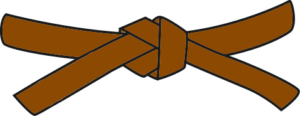
Brown represents the ripening of the seed, a maturing and harvesting process. A brown belt is an advanced student whose techniques are beginning to mature, and he/she is beginning to understand the fruits of hard work as a beginner.
【KIHON】 idou kihon - moving basics from gedan barai in zenkutsu dachi
- CHUDAN JUNZUKI (step in)
- SANBON RENZUKI (step in)
- JODAN AGE UKE, GYAKU ZUKI (step in)
- CHUDAN SOTO UKE, GYAKU ZUKI (step back)
- CHUDAN UCHI UKE, GYAKU ZUKI (as KOKUTSU DACHI) (step in)
- KOKUTSU SHUTO UKE, ZENKUTSU NUKITE (step back)
- MAE GERI (GEDAN KAKIWAKE) (step in)
- YOKO GERI KEAGE (in KIBA DACHI, right and left) (step in)
- YOKO GERI KEKOMI (in ZENKUTSU DACH) (step in)
【KATA】 HEIAN GODAN
【KUMITE】 JIYU IPPON KUMITE (JODAN JUNZUKI, CHUDAN JUNZUKI, CHUDAN MAE GERI) right and left
2nd Kyu Brown

Brown represents the ripening of the seed, a maturing and harvesting process. A brown belt is an advanced student whose techniques are beginning to mature, and he/she is beginning to understand the fruits of hard work as a beginner.
【KIHON】 idou kihon - moving basics from gedan barai in zenkutsu dachi
- JODAN JUNZUKI, CHUDAN GYAKU ZUKI (step in)
- JODAN AGE UKE, GYAKU ZUKI (step back)
- CHUDAN SOTO UKE, GYAKU ZUKI (step in)
- CHUDAN UCHI UKE, GYAKU ZUKI (step back)
- KOKUTSU SHUTO UKE, ZENKUTSU NUKITE (step in)
- MAE GERI (GEDAN KAKIWAKE) (step in)
- MAWASHI GERI (step in)
- YOKO GERI KEAGE (in KIBA DACHI, right and left) (step in)
- YOKO GERI KEKOMI (in ZENKUTSU DACHI) (step in)
【KATA】 TEKKI SHODAN
【KUMITE】 - JIYU IPPON KUMITE (JODAN JUNZUKI, CHUDAN JUNZUKI, CHUDAN MAE GERI, CHUDAN YOKO GERI KEKOMI, MAWASHI GERI) right and left
* Inform your choice of JODAN or CHUDAN for MAWASHI GERI
1st Kyu Brown

Brown represents the ripening of the seed, a maturing and harvesting process. A brown belt is an advanced student whose techniques are beginning to mature, and he/she is beginning to understand the fruits of hard work as a beginner.
【KIHON】 idou kihon - moving basics from gedan barai in zenkutsu dachi
- JODAN JUNZUKI, CHUDAN GYAKU ZUKI (step in)
- JODAN AGE UKE, GYAKU ZUKI (step back)
- CHUDAN SOTO UKE, YOKO ENPI, YOKO URAKEN
- UCHI (ZENKUTSU DACHI changing stance to KIBA DACHI) (step in)
- CHUDAN UCHI UKE, GYAKU ZUKI (step back)
- KOKUTSU SHUTO UKE, ZENKUTSU NUKITE (step in)
- MAE GERI (on the spot), MAE GERI (step in)
- MAWASHI GERI (step in)
- YOKO GERI KEAGE (in KIBA DACHI, right and left) (step in)
- YOKO GERI KEKOMI (ZENKUTSU DACHI) (step in)
【KATA】 BASSAI DAI
【KUMITE】- JIYU IPPON KUMITE (JODAN JUNZUKI, CHUDAN JUNZUKI, CHUDAN MAE GERI, CHUDAN YOKO GERI KEKOMI, MAWASHI GERI) right and left
* Inform your choice of JODAN or CHUDAN for MAWASHI GERI
DAN
Grading Criteria
DAN
Grading Criteria
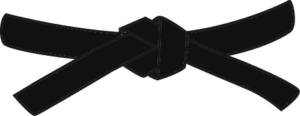
Black signifies the darkness beyond the Sun. A black belt seeks new, more profound knowledge of the Art. As he/she begins to teach others, he/she plants new seeds and helps them grow and mature. His/her students, many whom will form roots deep into the Art, blossom and grow through the ranks in a never-ending process of self-growth, knowledge, and enlightenment.
【KIHON】 IDO KIHON Moving basics
- SANBON RENZUKI (step in)
- JODAN AGE UKE, GYAKU ZUKI (step back)
- CHUDAN SOTO UKE, YOKOENPI, YOKOURA KENUCHI, GYAKUZUKI
- (ZENKUTSU DACHI changing stance to KIBA DACHI changing stance to ZENKUTSU DACHI) (step in)
- CHUDAN UCHI UKE, KIZAMI ZUKI, GYAKUZUKI (KOUKUTSU DACHI to ZENKUTSU DACHI) (step back)
- KOKUTSU SHUTO UKE, ZENKUTSU NUKITE (step in)
- MAE GERI (on the spot), MAE GERI (step in)
- MAWASHI GERI (step in)
- YOKO GERI KEAGE (KIBA DACHI – right and left) (step in)
- YOKO GERI KEKOMI (ZENKUTSU DACHI)
【KATA】 BASSAI DAI, KANKU DAI, ENPI or JION (your choice)
【KUMITE】 JIYU IPPON KUMITE (JODAN JUNZUKI, CHUDAN JUNZUKI, CHUDAN MAE GERI, CHUDAN YOKO GERI KEKOMI, MAWASHI GERI) right and left
* Inform your choice of JOUDAN or CHUUDAN for MAWASHIGERI
【KIHON】 IDO KIHON Moving basics
- CHUDAN JUNZUKI (step in)
- JODAN JUNZUKI, CHUDAN GYAKU ZUKI (step in)
- SANBON RENZUKI (step in)
- AGE UKE, SOTO UKE (with same arm), GYAKUZUKI (step back)
- UCHI UKE, KIZAMIZUKI, GYAKUZUKI (KOKUTSU DACHI to ZENKUTSU DACHI) (step in)
- KOKUTSHU SHUTOUKE, ZENKUTSU NUKITE (step back)
- MAE GERI (on the spot), MAE GERI (step in)
- YOKO GERI KEAGE, YOKO GERI KEKOMI (KIBA DACHI, alternate feet)
- YOKO GERI KEKOMI (ZENKUTSU DACHI) (step in)
- MAWASHI GERI, YOKO URA KEN UCHI, CHUDAN GYAKU ZUKI (step in)
【KATA】 Student’s favourite KATA
【KUMITE】 JIYU KUMITE
【KIHON】 (IDO KIHON Moving basics free KAMAE)
- KIZAMI ZUKI, JODAN JUNZUKI, CHUDAN GYAKUZUKI (step in)
- AGE UKE, SOTO UKE (with same arm), GYAKUZUKI (step back)
- UCHI UKE, KIZAMI ZUKI, GYAKU ZUKI (KOKUTSU DACHI to ZENKUTSU DACHI) (step in)
- KOKUTSU SHUTO UKE, KIZAMI MAE GERI, ZENKUTSU NUKITE (step back)
- MAE GERI - GYAKUZUKI, YOKO GERI KEKOMI - GYAKUZUKI, MAWASHI
- GERI - GYAKUZUKI (step in)
- USHIRO GERI (step in)
- MAE GERI, YOKO GERI KEKOMI, USHIROGERI (ZENKUTSU DACHI same feet right and left)
【KATA】 Student’s favorite KATA (Question and Answer Session)
【KUMITE】 JIYU KUMITE
【KIHON】 (IDO KIHON Moving basics free KAMAE)
- KIZAMI ZUKI, SANBON RENZUKI (step in)
- AGE UKE, SOTO UKE (with same arm), GYAKUZUKI (step back)
- UCHI UKE, KIZAMIZUKI, GYAKUZUKI (KOKUTSU DACHI, ZENKUTSU DACHI) (step in)
- KOKUTSU SHUTO UKE, KIZAMI MAE GERI, ZENKUTSU NUKITE (step back)
- MAE GERI, JUNZUKI, GYAKU ZUKI (step in)
- KIZAMI MAWASHI GERI, YOKO GERI KEKOMI, GYAKUZUKI (step in)
- MAE GERI, YOKO GERI KEKOMI, USHIROGERI (ZENKUTSU DACHI same feet right and left)
【KATA】 Student’s favorite KATA (Question and Answer Session)
【KUMITE】 JIYU KUMITE
【KIHON】 (IDO KIHON Moving basics free KAMAE)
- KIZAMI ZUKI, SANBON RENZUKI (step in)
- AGE UKE, SOTO UKE (with same arm), GYAKUZUKI (step back)
- UCHI UKE, KIZAMIZUKI, GYAKUZUKI (KOUKUTSU DACHI, ZENKUTSU DACHI) (step in)
- KOKUTSU SHUTO UKE, KIZAMI MAE GERI, ZENKUTSU NUKITE (step back)
- MAE GERI, JODAN JUNZUKI, CHUDAN GYAKUZUKI (step in)
- YOKO GERI KEKOMI, GYAKUZUKI (step in)
- MAWASHI GERI, GYAKUZUKI (step in)
- MAE GERI, YOKO GERI KEKOMI, MAWASHI GERI, GYAKUZUKI (step in)
【KATA】 from HEIAN SHODAN to TEKKI SANDAN - specified by examiner (Questions and Answers Session). Student’s favorite KATA (Question and Answer Session)
【KUMITE】 JIYU KUMITE
【KIHON】 Specified by examiner
【KATA】 from HEIAN SHODAN to TEKKI SANDAN, BASSAI DAI, KANKU DAI, ENPI, or JION – specified by examiner (Questions and Answers Session). Student’s favorite KATA (Question and Answer Session)
【KUMITE】 JIYU KUMITE
- Question and Answer Session on technique
- Submit a report on technique on the exam day (Submitted one week in advance
【KIHON】 Specified by examiner
【KATA】 Student’s favorite KATA (Question and Answer Session)
【KUMITE】 JIYUU KUMITE
- Question and Answer Session on technique
- Submit a report on technique on the exam day (Submitted one week in advance
Recommendation by Shihankai
Recommendation by Shihankai
Recommendation by Shihankai
Note <from 2nd Dan to 7th Dan> General KUMITE for men / women the age of 60 and above are required JIYU KUMITE or JIYU IPPON KUMITE (JODAN JUNZUKI, CHUDAN JUNZUKI, CHUDAN MAEGERI, CHUDAN YOKOGERI KEKOMI, MAWASHIGERI) right
* Inform JOUDAN or CHUDAN as for MAWASHIGERI
To progress to the next Kyu or Dan, JKA students must demonstrate exceptional skill and near flawless execution of a prescribed set of techniques and kata. JKA specially-trained instructors and examiners carefully study and evaluate each student based on the criteria shown by clicking on any rank on the chart above.

JKA links
Technical Manual For The Instructor
Tournament Rules & Regulations 2015
Dan Examination Record
Petition for holding DAN and license Test form
Request for JKA Instructors form (2017)
Examinee’s Information Card form
Issuance report of JKA DAN certificates form
JKA Member Register Sheet & Remittance Detail (2015)